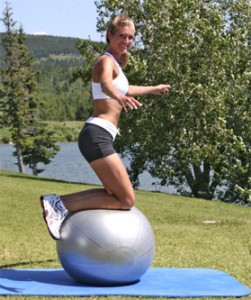Performance Enhancement Training Part 2: Core Stability Training
Posted on October 20th, 2016 by Andries Lodder

In last month’s issue we discussed in depth about Sport Specificity as the first part of performance enhancement training. We realised that we have to achieve equilibrium through integration of optimal functional strength, power, core stability, balance, proprioception, reaction time, agility, decision making and technique and that only when the body is at total equilibrium, an athlete can perform optimally.
This brings us to the second part of performance enhancement training, Core Stability. Why is core stability so important? How can it improve your performance? Does it help to prevent injuries? Will it really make that much of a difference? The answer to all these questions is a simple YES! But first you have to know what core stability is and which muscles groups combine to form your core.
Core stability is the name given to the strengthening of the core of muscles surrounding the back and abdomen. These muscles are also known as your body’s powerhouse and provide a solid base upon which all other muscles can work upon to initiate movement.
The core can be thought of as a cylinder of muscles around the inner surface of the abdomen. They comprise of your Transversus Abdominus (TA), Multifidus, Diaphragm and your Pelvic Floor.
Your TA is the deepest of all the abdominal muscles which lie underneath the oblique abdominals and your 6-pack muscle. This is the main core muscle that provides stability. It connects to the lumbar spine (lower back) and wraps around to meet in the middle of the front of the abdomen. When contracted it increases the pressure inside your abdomen and pulls tight on the lower back to provide excellent stability to your back.
Your Multifidus lies deep on your back on either side of the spine and connects to the whole lower back. Its main function is to provide stability during back extension as well as providing your upright posture.
Your Diaphragm is the primary muscle for breathing. Its domed shape provides the top of the cylinder of your core. When the TA contracts, the diaphragm tenses up to maintain pressure in the abdomen and therefore providing stability to the spine.
Lastly your Pelvic Floor. Renowned among pregnant women, the pelvic floor muscles provide a sling running from back to front, from the bottom tip of the spine (tail bone) to the front of the pelvis. Your pelvic floor and your TA contract concurrently to form the bottom of the cylinder of muscles.
When all these muscles contract together they keep the spine in its most stable position, and aid in preventing injury. These muscles contract before you move your arms or legs, therefore they function to keep your pelvic region stable during all movements. If you suffer from lower back pain, it indicates that your core muscles are not contracting before any limb movements, and leaves the spine exposed to injury. Therefore by retraining these muscles to contract at the right time forms the foundation of core stability.
By integrating everything it is safe to say that your whole body works in unison to form a kinetic chain. Therefore your core plays a very important role in linking your upper body to your lower body. Now, when your core stability is weak, your ability to efficiently transfer force through the torso to the upper body or lower body will be reduced, losing force generated during movements utilising your entire kinetic chain. This energy loss compromises the efficiency during competitive sports. This reason alone indicates the importance of core stability for athletic conditioning.
Therefore by training the core, the rest of the muscles in a specific area i.e. the hamstrings, gluteals, abdominal, back muscles, chest and arms all work more efficiently and together. By providing pelvic stability through core strength, you take the strain off all your other joints (knees and ankles), thus decreasing your chances of ankle or knee injuries.
Whether you a recreational runner or cyclist, or whether you’re an elite sports person, core stability should be the foundation of your initial training regime.
The difference between having the edge in your chosen sport will time and time again come down to your ability to maintain the most efficient functioning of your core muscles, hence the reason why people call it the Powerhouse of an Athlete.
Test yourself by sitting on a stability ball (Pilates ball) and while keeping your arms crossed over your chest, lift both legs slowly off the ground and maintain your balance, or for a greater challenge, kneel on the stability ball and try and keep your balance. If you can do this, you are well on your way to becoming the next powerhouse in your sporting field.
But before you get to chuffed with yourself, this is just the beginning of performance enhancement core training, our main aim is to get you to stand on the stability ball and do squats on it, or catch and throw medicine balls while maintaining your balance, and finally to bounce on it as if it’s your own trampoline.
Next month we will look in more depth at how eccentric training can improve strength and stability and in so doing enhance your performance.
Tweet